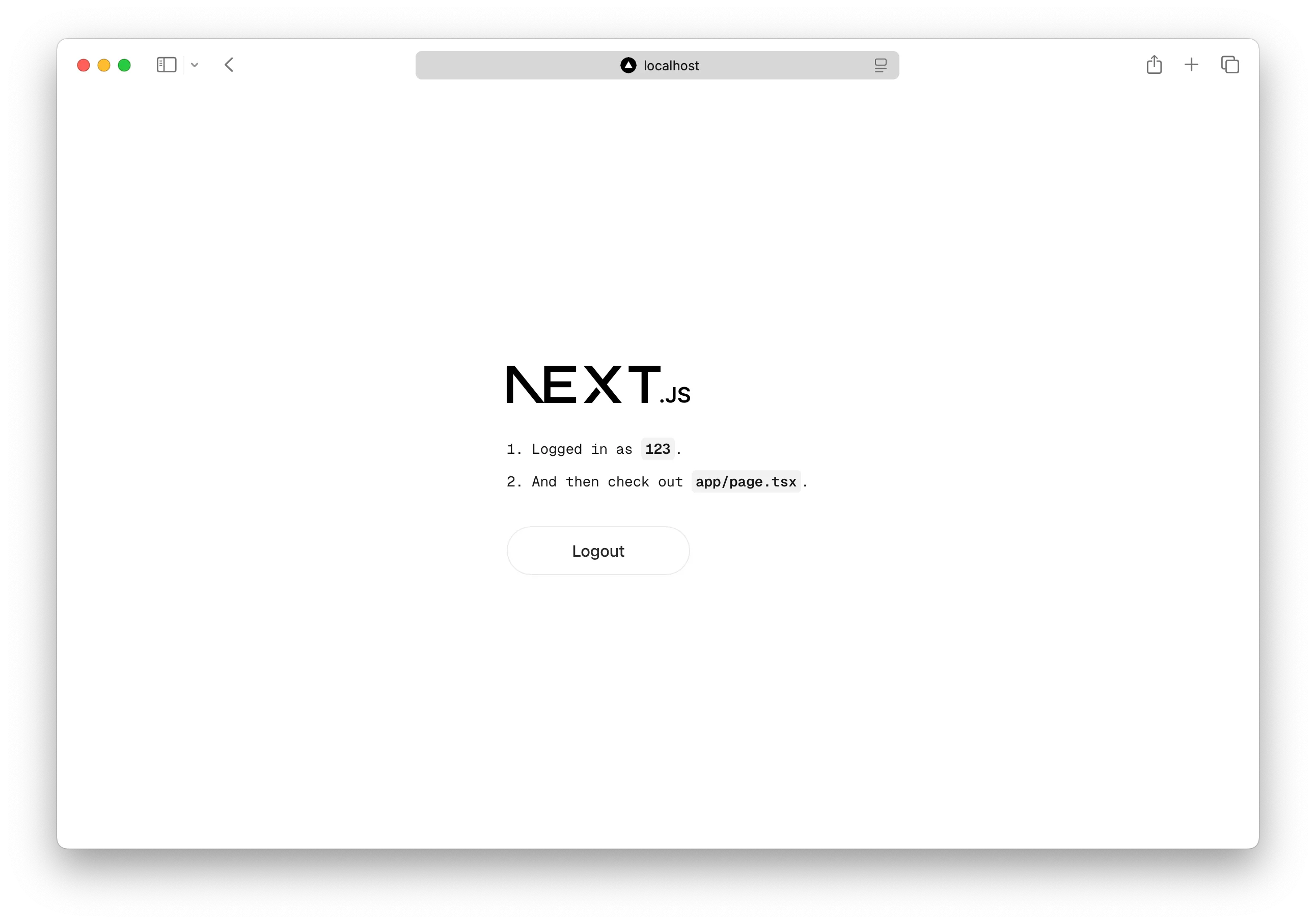OpenAuth with Next.js
Use OpenAuth to add authentication to your Next.js app.
We are going to create a new Next.js app and add authentication to it with OpenAuth.
We are going to authenticate users by sending them a code to verify their email address.
1. Create a project
Let’s start by creating our Next.js app and starting it in dev mode.
bun create next-app oa-nextjscd oa-nextjsbun devWe are picking TypeScript and not selecting ESLint.
This will start our Next.js app at http://localhost:3000.
2. Add OpenAuth server
Next, let’s add a directory for our OpenAuth server.
mkdir authAdd our OpenAuth server to a auth/index.ts file.
import { issuer } from "@openauthjs/openauth"import { CodeUI } from "@openauthjs/openauth/ui/code"import { CodeProvider } from "@openauthjs/openauth/provider/code"import { MemoryStorage } from "@openauthjs/openauth/storage/memory"import { subjects } from "./subjects"
async function getUser(email: string) { // Get user from database and return user ID return "123"}
export default issuer({ subjects, storage: MemoryStorage(), providers: { code: CodeProvider( CodeUI({ sendCode: async (email, code) => { console.log(email, code) }, }), ), }, success: async (ctx, value) => { if (value.provider === "code") { return ctx.subject("user", { id: await getUser(value.claims.email) }) } throw new Error("Invalid provider") },})Define subjects
We are also going to define our subjects. Add the following to a auth/subjects.ts file.
import { object, string } from "valibot"import { createSubjects } from "@openauthjs/openauth/subject"
export const subjects = createSubjects({ user: object({ id: string(), }),})Let’s install our dependencies.
bun add @openauthjs/openauth valibotAnd add a script to start our auth server to package.json.
"dev:auth": "PORT=3001 bun run --hot auth/index.ts",Now run the auth server in a separate terminal.
bun dev:authThis will start our auth server at http://localhost:3001.
3. Add OpenAuth client
Next, let’s add our OpenAuth client to our Next.js app. Add the following to app/auth.ts.
import { createClient } from "@openauthjs/openauth/client"import { cookies as getCookies } from "next/headers"
export const client = createClient({ clientID: "nextjs", issuer: "http://localhost:3001",})
export async function setTokens(access: string, refresh: string) { const cookies = await getCookies()
cookies.set({ name: "access_token", value: access, httpOnly: true, sameSite: "lax", path: "/", maxAge: 34560000, }) cookies.set({ name: "refresh_token", value: refresh, httpOnly: true, sameSite: "lax", path: "/", maxAge: 34560000, })}Here we are assuming that our auth server is running at http://localhost:3001. Once the user is authenticated, we’ll be saving their access and refresh tokens in http only cookies.
Add auth actions
Let’s add the server actions that our Next.js app will need to authenticate users. Add the following to app/actions.ts.
"use server"
import { redirect } from "next/navigation"import { headers as getHeaders, cookies as getCookies } from "next/headers"import { subjects } from "../auth/subjects"import { client, setTokens } from "./auth"
export async function auth() { const cookies = await getCookies() const accessToken = cookies.get("access_token") const refreshToken = cookies.get("refresh_token")
if (!accessToken) { return false }
const verified = await client.verify(subjects, accessToken.value, { refresh: refreshToken?.value, })
if (verified.err) { return false } if (verified.tokens) { await setTokens(verified.tokens.access, verified.tokens.refresh) }
return verified.subject}
export async function login() { const cookies = await getCookies() const accessToken = cookies.get("access_token") const refreshToken = cookies.get("refresh_token")
if (accessToken) { const verified = await client.verify(subjects, accessToken.value, { refresh: refreshToken?.value, }) if (!verified.err && verified.tokens) { await setTokens(verified.tokens.access, verified.tokens.refresh) redirect("/") } }
const headers = await getHeaders() const host = headers.get("host") const protocol = host?.includes("localhost") ? "http" : "https" const { url } = await client.authorize(`${protocol}://${host}/api/callback`, "code") redirect(url)}
export async function logout() { const cookies = await getCookies() cookies.delete("access_token") cookies.delete("refresh_token")
redirect("/")}This is adding an auth action that checks if a user is authenticated, login that starts the OAuth flow, and logout that clears the session.
Add callback route
When the OpenAuth flow is complete, users will be redirected back to our Next.js app. Let’s add a callback route to handle this in app/api/callback/route.ts.
import { client, setTokens } from "../../auth"import { type NextRequest, NextResponse } from "next/server"
export async function GET(req: NextRequest) { const url = new URL(req.url) const code = url.searchParams.get("code")
const exchanged = await client.exchange(code!, `${url.origin}/api/callback`)
if (exchanged.err) return NextResponse.json(exchanged.err, { status: 400 })
await setTokens(exchanged.tokens.access, exchanged.tokens.refresh)
return NextResponse.redirect(`${url.origin}/`)}Once the user is authenticated, we redirect them to the root of our app.
4. Add auth to app
Now we are ready to add authentication to our app. Replace the <Home /> component in app/page.tsx with the following.
import { auth, login, logout } from "./actions"
export default async function Home() { const subject = await auth()
return ( <div className={styles.page}> <main className={styles.main}> <Image className={styles.logo} src="/next.svg" alt="Next.js logo" width={180} height={38} priority /> <ol> {subject ? ( <> <li> Logged in as <code>{subject.properties.id}</code>. </li> <li> And then check out <code>app/page.tsx</code>. </li> </> ) : ( <> <li>Login with your email and password.</li> <li> And then check out <code>app/page.tsx</code>. </li> </> )} </ol>
<div className={styles.ctas}> {subject ? ( <form action={logout}> <button className={styles.secondary}>Logout</button> </form> ) : ( <form action={login}> <button className={styles.primary}>Login with OpenAuth</button> </form> )} </div> </main> </div> )}Let’s also add these styles to app/page.module.css.
.ctas button { appearance: none; background: transparent; border-radius: 128px; height: 48px; padding: 0 20px; border: none; border: 1px solid transparent; transition: background 0.2s, color 0.2s, border-color 0.2s; cursor: pointer; display: flex; align-items: center; justify-content: center; font-size: 16px; line-height: 20px; font-weight: 500;}
button.primary { background: var(--foreground); color: var(--background); gap: 8px;}
button.secondary { border-color: var(--gray-alpha-200); min-width: 180px;}4. Test your app
Head to http://localhost:3000 and click the login button, you should be redirected to the OpenAuth server asking you to put in your email.
If you check the terminal running the auth server, you’ll see the code being console logged. You can use this code to login.

This should log you in and print your user ID.
Deploy your app
To are now ready to deploy your app and your OpenAuth server. A couple of changes you’ll need to make.
- Use a more persistent
storagelike DynamoDB or Cloudflare KV in yourauth/index.ts. - Instead of printing out the code, email that to the user.
- Finally, in your
app/auth.ts, use the deployed auth server URL instead ofhttp://localhost:3001.
You can also check out the SST quick start for a fully deployed example.